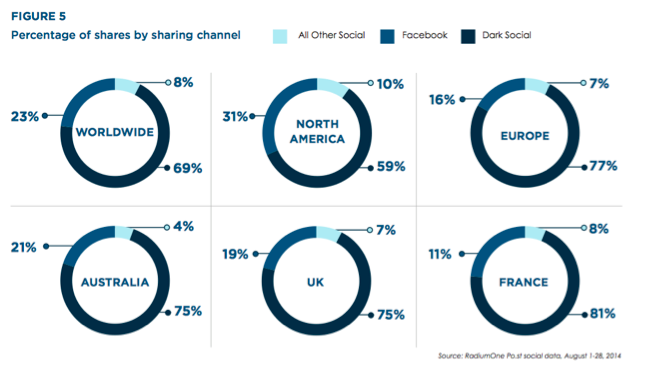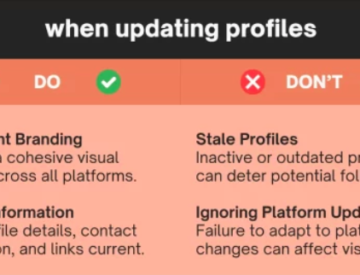In this digital era, what would you say is the estimated percentage of word of mouth taking place online? As shocking as this may sound, recent research conducted by Ed Keller and Brad Fay shows this number is actually only… 7%!
In other words, most of the sharing still takes place offline, by the water cooler, the coffee machine, the office cubicle, in public transit or at the family dining table.
Only 7% of word of mouth takes place online, according to researchClick To TweetBut make no mistake: we do share online. A lot. In fact, by the end of 2014 there were an estimated 1.8 billion social sharers around the world, representing 63.4% of all internet users, or 25% of the global population. But sharing online and sharing across various social networks is not the same thing!
The Emergence of Dark Social
Dark social sharing occurs when people share content digitally, but not directly through measurable social networks. The classic example is when people copy and paste content or links from a website, directly into the body of an email or text message, then share it with one or many recipients.
These private messages fly under the radar of usual social media marketing tracking, whether this is measured with Google Analytics or other sophisticated tools.

So just how much dark social sharing takes place? Brace yourself… according to a RadiumOne study conducted in October 2014, of the 84% of internet users sharing digitally, more than 9 out of 10 actually share their content through dark social channels!
Dark social represents 69% of all social sharing, while Facebook takes 23% and all other social channels count for 8%
Segmenting by age shows slight variations, as older (55+) generations tend to embrace even more dark social channels, presumably email. Interestingly enough, we can also see variations per geographic location, showing that for example dark social is strongest in France, while moderately so in the United States.

What impact in travel marketing?
These stats may surprise some, but most people will acknowledge this reality of digital travel marketing. In fact, most times I speak with hoteliers, destinations or restaurateurs about social media or TripAdvisor, for instance, many will tell me their frustrations about not getting written feedback from customers.
They serve dozens or hundreds of customers daily, yet only get a fraction of these (mostly happy) customers to share their experience online, through customer surveys or via review sites. Yet, they KNOW that these happy customers are talking about their experiences with friends, family and colleagues… So how do we get more of them to share digitally and socially, on recognized channels that don’t fly under thew radar? Here are some learnings and recommendations:
-
Sollicit feedback
If you know your best and most loyal clients are raving about your travel brands offline, then you need to make sure you get them to put in writing. Easier said than done, but make sure you let them know about your presence on Yelp or TripAdvisor through table tents on restaurant tables, in lobby elevators and, most effectively, through personalized emails sent after a stay or dining experience at your property.
Read: 3 Tips to Rank Higher on TripAdvisor
-
Content marketing is key
Notice that through dark social channels, we tend to copy and paste content, whether it is text, photo or video, an infographic, a quote or a humorous visual. This begs the question: where was this content to begin with?
There are many brands out there questioning the relevance of having a corporate blog, yet this is where travel destinations, hotels or festivals and events can tell their brand story. And this is what gets shared, specially when the content stirs emotions, conveys an experience or an aspirational getaway.
Read: How To Apply Content Marketing to Hospitality
-
Facebook IS measurable
Yes, there is an insane amount of sharing that takes place through dark social channels, but 23% of the social sharing we can track actually takes place through Facebook, with only 8% for all other channels, presumably Twitter, Linkedin, Pinterest, Instagram and Google+.
In North America, this percentage is even higher, at 31%, so travel brands should continue to embrace the potential of Facebook marketing, in particular for targeting niche audiences and amplifying content through paid tactics, including videos which are booking on this social network.
Read: Social Media Best Practices in Travel: Facebook
-
Email remains of utmost importance
We tend to forget it, but there are presently three times more email accounts than Facebook and Twitter accounts… combined! According to Radicati, by 2017 it is estimated that 207 billions emails will be sent out daily. Thus, email is still much more widespread in the US than social media, and reports of its death are grossly overstated and misconstrued.
So since so many people still use emails, travel brand must make sure to deploy quality email-friendly content, which in 2015 also means mobile-friendly email content, since more than 53% of newsletters and emails get opened on mobile devices. Do you have a “send to a friend” button on that newsletter you send out? Do you include your latest blog post in your corporate email signature?
Read also: 5 Tips for a Better Email Signature
-
Pay attention to social signals
Finally, make sure you take a close look at your site analytics to find the hidden gems that may be hiding in some traffic statistics. In a recent post, Mark W. Schaefer gave the example of a marketing manager who found, after deep-diving into the corporate blog’s analytics, that there were a few consistent shares coming from the same little-known app.
After much research, it’s actually through a Linkedin discussion that this manager found a group of fans who were avidly using this app sharing the corporate blog’s content amongst colleagues. Morale of this story? Pay attention to signals that can point in the direction of loyal customers or fans that may not be sharing through known or usual channels.
Read: Your Marketing May Hinge on Gray Social Media
So what do you believe may be the impact of dark social on your business? Let me know in the comment section below!









Leave a Reply